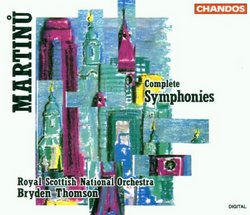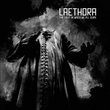| All Artists: Bohuslav Martinu, Bryden Thomson, Royal Scottish National Orchestra Title: Martinu: Complete Symphonies Members Wishing: 0 Total Copies: 0 Label: Chandos Release Date: 7/12/1993 Genre: Classical Styles: Historical Periods, Modern, 20th, & 21st Century, Symphonies Number of Discs: 3 SwapaCD Credits: 3 UPC: 095115910320 |
Search - Bohuslav Martinu, Bryden Thomson, Royal Scottish National Orchestra :: Martinu: Complete Symphonies
 | Bohuslav Martinu, Bryden Thomson, Royal Scottish National Orchestra Martinu: Complete Symphonies Genre: Classical
These six symphonies deserve a place in everyone's record collection. If you like modern, melodic symphonies--Shostakovich, Prokofiev, Vaughan Williams, or Copland, for instance--then these luminous, attractive scores ar... more » |
Larger Image |
CD DetailsSynopsis
Amazon.com These six symphonies deserve a place in everyone's record collection. If you like modern, melodic symphonies--Shostakovich, Prokofiev, Vaughan Williams, or Copland, for instance--then these luminous, attractive scores are just the ticket. All were composed right here in the good old USA and premiered by our greatest orchestras. Martinu's refusal to return to Communist Czechoslovakia after the Second World War led to his neglect for years in his own country, and this in turn contributed to his obscurity in the years immediately following his death in 1959. Now he seems to be coming into his own, and these three magnificently played and recorded discs are a great way to take the plunge. - -David Hurwitz Similar CDs
|
CD ReviewsFirst-Rate R. Albin | Ann Arbor, Michigan United States | 11/30/2003 (5 out of 5 stars) "This is an excellent set of recordings of the Martinu symphonies. Martinu's orchestral work is both lovely and fascinating. There is much beautiful, lyrical music in these symphonies and Martinu's ability to bring forth unexpected and wholly satisfactory turns in the music is simply remarkable. Very satisfying listening and this complete set is an excellent way to experience some of Martinu's best work." Fantastic Martinu Cycle, now reissued R. Hutchinson | a world ruled by fossil fuels and fossil minds | 03/10/2010 (5 out of 5 stars) "I've been listening to this Chandos box of Martinu symphonies for a couple of years now. It's great, and now that I have Jarvi's cycle for comparison, I've written a review. (This set has since been reissued -- look for the more recent box version.)
Bohuslav Martinu (1890-1959) only began composing symphonies after fleeing the Nazis into American exile in 1941. He was of a generation that saw the symphony as passe -- Bartok was born in 1881 and Stravinsky in 1882, and Martinu was born in 1890 -- while Mahler was born in 1860, and Sibelius and Nielsen in 1865. Modernism entailed new forms and styles, and while Martinu was never a modernist he did inhabit a soundworld with a lighter touch full of dance rhythms, not heavy, four-square symphonies. But he received a commission from Koussevitsky and the Boston Symphony, so he wrote a symphony. And then another, and another... He ended up composing a symphony a year every year from 1942 to 1946, No.s 1 through 5, and later a Sixth, his most popular. They are graceful, full of dancing rhythms, and of classical proportions, ranging from 23 to 36 minutes in length. Symphonies 1, 2 and 4 are in the traditional four-movement form, while No.s 3, 5 and 6 each have three movements. The First, Third and Sixth were premiered by the Boston Symphony, the Second was premiered by the Cleveland Orchestra, the Fourth was premiered by the Philadelphia Orchestra, and the Fifth is unique in having been premiered by the Czech Philharmonic and Rafael Kubelik. Symphony No. 1 demonstrated that Martinu's gifts, previously applied to the concerto grosso form, all manner of chamber music, and opera, could be applied to great effect to the symphonic form, despite his misgivings. Its success spurred him on. Symphony No. 2 is shorter and uses Czech and Moravian folk melodies in the slow movement, his most Czech symphony, and features the use of several small groups of instruments. Symphony No. 3 stands out from the others in its dark and somber hue. While parts of the First and Second had reflected the war, the Third is clearly marked by it through and through. It is Martinu's only work that reminds me of Shostakovich in its gravity and tragic cast. It is a powerful work which ends without a triumphant resolution, despite Beethoven's Eroica being an inspiration and despite the D-Day landing at Normandy taking place shortly before Martinu completed it. Though atypical, I consider this to be one of the finest jewels in this string of six. The Fourth complements the Third perfectly as it celebrates victory. The second movement Allegro vivo reminds me of nothing so much as the scherzo to Beethoven's 9th, a propulsive dancing march rhythm. It has the forward momentum of the opening of Roussel's Third Symphony, but is lighter on its feet. And the Poco allegro finale is an ecstatic celebration, the triumph that was withheld at the conclusion of the Third. The Fifth is more questing and tentative after that burst of enthusiasm. It was first heard at the inaugural Prague Spring Festival in 1947. A head injury caused by a fall from an open second-floor terrace led to several years of expensive treatment and convalesence, but Martinu returned to composing at the peak of his powers. The Sixth was finished in 1953, and is the most broadly Romantic of his symphonies, sounding like Copland in parts with lush, sweeping melodies, and using the melody "Across the Wide Missouri," though I've never seen this mentioned anywhere. Listen for yourself and see. It remains one of Martinu's most popular works. This box, with Bryden Thomson leading the Royal Scottish National Orchestra,is now in direct competition with the Brilliant box with Neemi Jarvi leading the Bamberg Symphony Orchestra. They were recorded at about the same time -- Jarvi's cycle, originally on BIS, in 1987/1988, and Thomson's in 1989/1990. The Jarvi set combines the works chronologically, with 1 & 2 on Disc One, 3 & 4 on Disc Two, and 5 & 6 on Disc Three. The Chandos box pairs 1 & 5, 2 & 6 and 3 & 4. I prefer the chronological ordering myself. The Chandos box is a "true box" with the discs in cardboard sleeves, while the Brilliant set is not actually a box, but rather a fold-out with three jewel-case inserts for the discs. This box is more elegant. Some have reached the sweeping conclusion that the Thomson set is faster than the Jarvi set. This is not totally accurate. Comparing movement by movement, Jarvi is actually faster in 8, while Thomson is faster in 13. It is true that Jarvi takes the slow movements more slowly, but the overall timing does not dramatically differ between the two. And while both cycles are fine accomplishments, I would not be without Jarvi's Third, which I prefer decisively over Thomson's because the opening is *faster.* Overall Thomson excels in bringing out the dancing rhythms in Martinu, a key element of his style, while Jarvi is better at accentuating the more classical, more Germanic, elements, but these differences are relatively minor. If you are a symphony lover, and/or someone interested in hearing great early 20th century classical music, you should definitely not miss the symphonies of Martinu! " |

 Track Listings (7) - Disc #1
Track Listings (7) - Disc #1

